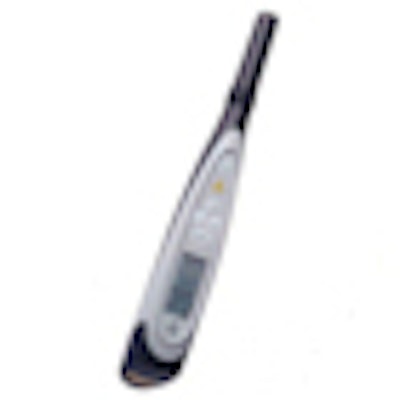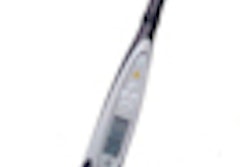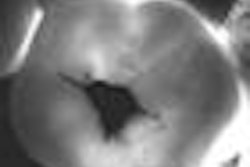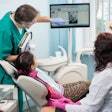
The ability of laser fluorescence to assist in the early detection of occlusal and smooth surface caries has been well documented. But are tools such as the Diagnodent effective in determining the extent of pit-and-fissure caries prior to tooth preparation, or can they lead to overtreatment?
Not effective enough, according to a study in the Journal of Esthetic and Restorative Dentistry (JERD, February 2010, Vol. 22:1, pp. 31-39).
André Ritter, D.D.S., M.S., and colleagues from the University of North Carolina set out to evaluate how laser fluorescence readings correlate with lesion extent, or depth of penetration, under controlled conditions. The implication, Dr. Ritter told DrBicuspid.com, was that if there was good correlation, the tool could be used to inform clinical decisions in cases in which routine assessment methods were inconclusive.
“The poor specificity of the Diagnodent readings ... has important implications for clinicians.”
The researchers collected 103 permanent molars and premolars containing incipient occlusal pit-and-fissure caries and sound occlusal surface from clinics at the university. Diagnostic readings were taken using the Diagnodent (KaVo Dental) according to the manufacturer's specifications.
After the diagnostic tests were performed, the suspected incipient occlusal caries lesion was removed using ¼ round burs. A combination of visual and tactile criteria was used to determine if all caries/stains had been removed.
Following tooth preparation, the amount of tooth structure removed was quantified by packing the preparation with composite resin and measuring the volume of composite needed to fill the preparation. Sensitivity and specificity using different cutoff values (20 and 30) were calculated for lesions and preparations extending into the dentin, and the results were analyzed statistically using the Pearson correlation with a significance level of 0.05 for all tests.
"Comparison with previously published results is problematic because the great majority of the studies have only evaluated the correlation between laser fluorescence readings and depth of caries lesions," the authors wrote. "The reason for evaluating the correlation between laser fluorescence readings and volume instead of depth was because ... the volume measurement may be more representative of lesions extension, as it offers a multidimensional perspective."
Clinical implications
The researchers observed a weak correlation between the mean Diagnodent values and the volume of tooth preparation (r = 0.285, p > 0.05). Sensitivity and specificity of the Diagnodent for detecting dental lesions were 0.83 and 0.60 for the cutoff value of 20 and 0.67 and 0.73 for the cutoff value of 30, respectively.
These findings suggest a small to moderate correlation between laser fluorescence readings (as measured by the Diagnodent) and the volume of tooth preparation as a surrogate measure of the extent of occlusal caries lesions, the authors wrote. In other words, they noted, higher Diagnodent readings may not necessarily represent increasingly advanced caries.
"The poor specificity of the Diagnodent readings ... has important implications for clinicians," they wrote. "Low specificity results in an increased likelihood of false-positive diagnoses and leads the clinician to intervene restoratively in a surface that may actually not be carious. ... Consequently, therapy guidelines proposed based on the Diagnodent readings may not be valid."
Although the sensitivity of Diagnodent for detecting dentinal lesions on occlusal surfaces was high, "the considerable likelihood of unnecessary treatment (false-positive results) may preclude the use of Diagnodent as a primary method of caries diagnosis," they concluded.
The study findings corroborate previous work (for example, Operative Dentistry, May-June 2006, Vol. 31:3, pp. 129-134; and March-April 2009, Vol. 34:2, pp. 136-141) that shows "the inadequate sensitivity and specificity of the laser fluorescence device in terms of its ability to predict the depth/extent of pit-and-fissure caries lesions," wrote Joel Berg, D.D.S., M.S., of the University of Washington School of Dentistry in a commentary that accompanied the JERD study (February 2010, Vol. 22:1, pp. 40-41). "[O]ne must consider whether any single device or technique can provide all of the information needed to determine the need for cutting into the pits and fissures of the occlusal surface."
Emerging technologies
Deanna Duke, product manager for KaVo North America and Pelton & Crane, noted that the Diagnodent should be used as an adjunct to other assessment methods within an overall patient care program.
"The value that Diagnodent brings to any practice is that the measurements derived, along with conventional methods such as exploration and x-ray, will help to guide overall caries treatment decisions," she said in a statement to DrBicuspid.com. A doctor or clinician should also rely on their own skill, care, and judgment, as with any treatment, she added.
"The bottom line is that, no matter how much we want it, at this time there is no one simple, objective, and accurate device for detection of presence, extent, and activity of dental caries," Dr. Ritter said. "Still, the best method of assessment for incipient occlusal caries is a combination of caries risk assessment, visual examination, and quality radiographic screening."
However, he added, a number of new technologies show promise for improved caries detection, including quantitative laser fluorescence, optical coherence tomography, hard-tissue ultrasound, and micro-CT.
"The overriding principle of minimally invasive dentistry is that disease should be prevented and, if prevention fails, that caries lesions should be treated early to preserve healthy tooth structure and minimize morbidity," he said. "This is where these emerging technologies can make a substantial contribution, by providing a more objective and conclusive diagnosis of the presence/absence of caries lesions and of their extent and activity. When used in conjunction with other, more established assessment methods, these new assessment methods can be very useful."
Copyright © 2010 DrBicuspid.com



















